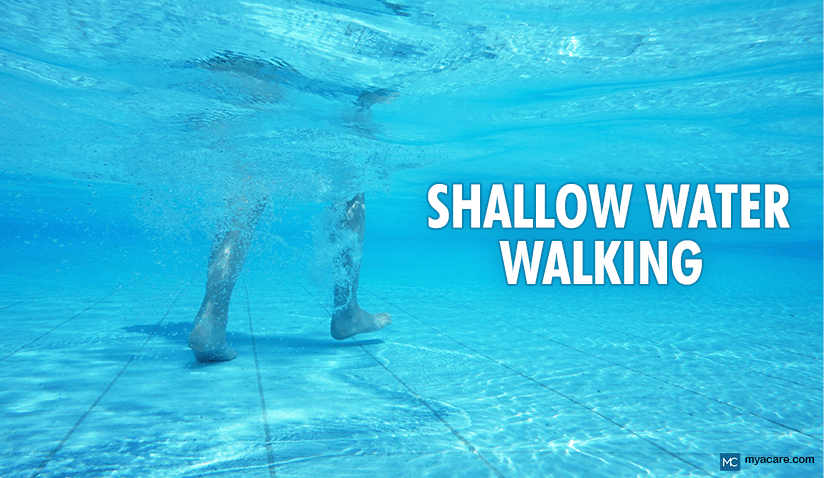Shallow Water Walking: Low-Impact Exercise for Joint and Functional Recovery

Medically Reviewed by Dr. Sony Sherpa, (MBBS)
What is Shallow Water Walking?
Mental and Emotional Health Benefits
Shallow water walking is a low-impact exercise that has gained popularity among seniors, athletes recovering from injuries, and fitness enthusiasts. As a form of aquatic therapy or hydrotherapy, it leverages the natural properties of water - buoyancy, resistance, and hydrostatic pressure - to provide a safe and effective workout.
Recognized as a therapeutic modality, shallow water walking is widely used in rehabilitation and fitness programs. Organizations such as the American Physical Therapy Association (APTA) and the Arthritis Foundation endorse aquatic exercises as a means to improve mobility, reduce pain, and enhance overall well-being.
Understanding Shallow Water Walking
Shallow water walking is a low-impact aquatic exercise performed in water that typically reaches between waist and chest depth. At this depth, the body experiences buoyancy, which reduces weight-bearing stress on the joints, and water resistance, which enhances muscle engagement and cardiovascular effort. This form of exercise is commonly practiced in pools, lakes, and coastal areas.
One of the key advantages of shallow water walking is that it can be performed by people of all ages and fitness levels, from seniors with arthritis to athletes recovering from injuries, as well as individuals seeking a low-impact alternative to land-based exercise. Unlike high-intensity aquatic activities such as swimming, shallow water walking does not require advanced skills, making it a practical choice for beginners and those with limited mobility.
Shallow Water Walking vs. Other Forms of Walking and Exercise
Shallow water walking differs from other forms of walking or water-based exercises in several ways:
- Compared to deep-water walking, which is performed in water deep enough that the feet do not touch the bottom, shallow water walking allows for partial weight-bearing and more controlled movement. Deep-water walking often requires a flotation device and engages the core more intensely to maintain stability.
- Unlike swimming, which involves full-body propulsion, shallow water walking primarily targets the lower-body muscles while still engaging the core and upper body. It is less intense than swimming but offers a safer and more accessible option for those who may not be comfortable in deep water.
- Walking in water provides greater resistance than walking on land, increasing muscle activation and energy expenditure while reducing joint stress. Studies suggest that even moderate-paced water walking can burn more calories than land walking due to the added resistance of water.
Shallow Water Walking in Different Environments
- Pool Walking: Offers a controlled environment with stable water conditions, making it ideal for structured therapy and exercise programs.
- Walking in Natural Water Bodies (Lakes, Rivers, Oceans): Factors such as waves, currents, and uneven terrain present additional challenges, which can improve balance and coordination yet require more effort. Sea wading or walking along the shoreline provides added resistance from sand and water movement, enhancing muscle engagement and stability training while also promoting sensory stimulation and relaxation.
Physical Health Benefits of Shallow Water Walking
Low-Impact Exercise
Shallow water walking is a gentle exercise that minimizes stress on the body's joints. The buoyancy provided by water supports a portion of body weight, reducing the impact on knees, hips, and ankles. This makes it particularly suitable for individuals with arthritis, those recovering from injuries, or people managing weight concerns, as it allows for movement and exercise without exacerbating joint discomfort.
Cardiovascular Fitness
Engaging in water walking can enhance cardiovascular health. The resistance encountered while moving through water requires the heart to work harder, thereby increasing heart rate and improving circulation. This aquatic activity offers a heart-healthy workout that is both effective and gentle on the body.
Muscle Strengthening and Toning
The natural resistance of water effectively works multiple muscle groups. As you walk through water, your legs, core, and arms engage more intensely than they would during land walking. This increased resistance helps strengthen and tone muscles, offering a balanced approach to building muscular endurance and strength.
Improved Flexibility and Range of Motion
Water's supportive environment allows for a greater range of motion during exercise. The gentle resistance and buoyancy enable movements that might be challenging on land, facilitating improved flexibility. Moreover, the warmth of the water relaxes muscles, which further enhances flexibility and reduces stiffness.
Enhanced Balance and Stability
Navigating through water challenges the body's proprioception, or sense of position, which in turn improves balance and stability. This aspect of water walking is particularly beneficial for older adults, as it strengthens the stabilizing muscles and enhances coordination, thereby reducing fall risk.
Calorie Burning and Weight Management
Water walking is an effective exercise for burning calories and managing weight. The resistance of water increases energy expenditure compared to land walking. An individual's body weight and exercise intensity are other factors that affect the calories burned. Energy expenditure through water walking can range from 240 to 356 calories per hour, compared to 214 to 318 calories per hour brisk walking on land. This activity supports fat loss while preserving muscle mass, contributing to overall weight management goals.
Mental and Emotional Health Benefits of Shallow Water Walking
Stress Reduction and Relaxation
Water's inherent soothing qualities, coupled with the rhythmic movement of walking, provide a calming exercise experience. Engaging in water walking can help reduce stress levels and promote relaxation, providing a meditative effect that benefits mental well-being.
Mood Enhancement
Physical activity, such as water walking, triggers the release of endorphins, the body's natural mood enhancers. Consistent physical activity of this kind can boost mood and cultivate a more positive outlook.
Social Interaction
Participating in group water walking classes or sessions offers opportunities for social engagement. Exercising with others fosters motivation, accountability, and a sense of community, enriching the overall experience and supporting emotional well-being.
Benefits for Specific Populations
Geriatric Rehabilitation
Shallow water walking is widely used in geriatric rehabilitation due to its low-impact nature and the supportive properties of water. For seniors, this form of exercise improves mobility, reduces joint pain, and enhances balance, which can help prevent falls. Water resistance effectively strengthens muscles without strain or injury, making it a safe and beneficial exercise, particularly for individuals with conditions such as arthritis, osteoporosis, or limited mobility. Studies have shown that regular participation in water-based exercises contributes to improved cardiovascular health, increased flexibility, and a higher overall quality of life in seniors.
Pregnant Women
Water walking is an excellent exercise for pregnant women, providing a safe way to stay active while minimizing stress on the joints and lower back. The buoyancy of water helps relieve pressure on the spine, reducing common pregnancy-related discomforts such as back pain and swelling in the legs. The gentle resistance of water also supports light strength training, helping to maintain muscle tone and build endurance, which can be beneficial during labor and postpartum recovery. The cooling effect of water also helps regulate body temperature, making exercise during pregnancy more comfortable.
Recovering from Injuries or Surgery
For those recovering from sports injuries, surgeries, or chronic pain conditions, shallow water walking serves as an effective rehabilitation tool. The reduced weight-bearing stress allows individuals to regain strength and mobility without excessively straining healing tissues. Water resistance can be adjusted based on movement speed, making it adaptable to different recovery stages. Conditions such as knee injuries, post-operative joint replacement rehabilitation, and musculoskeletal disorders can benefit from controlled aquatic therapy programs.
Neurological Conditions and Disabilities
Those with neurological conditions such as stroke, Multiple Sclerosis, or Parkinson’s disease often experience difficulties with balance, coordination, and muscle strength. Water provides a safe and supportive environment that allows for greater mobility and movement that might not be possible on land. The hydrostatic pressure of water improves circulation, while buoyancy aids in movement and reduces the risk of falls. For individuals with disabilities, aquatic therapy can serve as an inclusive exercise option that supports mobility, muscle engagement, and functional independence.
Weight-Related Health Issues
Beyond its role in weight management, shallow water walking can help alleviate health conditions associated with excess weight. Obesity-related conditions such as osteoarthritis, type 2 diabetes, and sleep apnea can improve with regular participation in water-based exercises. The reduction of joint stress in water makes movement easier for individuals with obesity, while the resistance encourages muscle engagement and calorie burning. Improved circulation and metabolic benefits from aquatic exercise can also aid in managing blood sugar levels and reducing the impact of weight-related conditions on overall health.
Tips for Effective Shallow Water Walking
Maintain Proper Posture and Technique
To maximize the benefits of shallow water walking, it is important to maintain good posture. Keep your back straight, shoulders relaxed, and engage your core. Maintain a natural walking pattern with a heel-to-toe motion, keeping your posture upright without leaning too far forward or backward to stay balanced. Moving your arms can enhance stability and also offer an added upper-body workout.
Adjust Intensity and Speed Gradually
Beginners should start at a comfortable pace, focusing on controlled movements. Over time, intensity can be increased by varying speed, incorporating interval walking, or adding directional changes, such as side steps or backward walking, to engage different muscle groups.
Incorporate Resistance Equipment
For a more challenging workout, resistance tools such as hand paddles, water weights, or webbed gloves can be used to engage the arms and upper body. Some pools also feature underwater treadmills, which provide a controlled environment for low-impact walking with adjustable resistance levels.
Consider Water Temperature
Water temperature plays a role in comfort and muscle function. Warmer water (around 86-92°F) is ideal for therapeutic and rehabilitation purposes, as it helps relax muscles and improve flexibility. Cooler water (78-82°F) may be more suitable for cardiovascular and endurance-focused workouts, as it helps regulate body temperature during exercise.
Safety and Precautions
Warm-Up and Cool-Down
Just like land-based exercises, warming up before starting and cooling down afterward helps prevent muscle strain and stiffness. Gentle stretching and slow-paced movements before and after walking sessions can improve flexibility and circulation.
Sun Protection and Hydration
For those walking in outdoor pools or natural water bodies, sun protection is essential. Wearing a hat, applying waterproof sunscreen, and using UV-protective swimwear can help prevent sunburn. Hydration is also important, as water exercise can still lead to fluid loss through sweating.
Wear Water Shoes
Water shoes provide a better grip on pool floors and natural surfaces, reducing the risk of slipping. They also protect the feet from sharp objects, rough surfaces, or unexpected depth changes in natural water environments.
Be Aware of Surroundings
When walking in pools, be cautious of slippery edges and sudden depth changes. In natural bodies of water, be mindful of currents, waves, and uneven terrain.
Consult a Healthcare Provider if Needed
Individuals with balance issues, heart conditions, or other medical concerns should seek medical advice before starting a shallow water walking routine.
Signs to Stop Exercising
If you experience dizziness, shortness of breath, chest pain, or persistent joint discomfort, stop exercising immediately and consult a doctor if needed.
Potential Drawbacks
While shallow water walking offers numerous benefits, there are a few potential drawbacks:
- Limited weight-bearing benefits: Since water reduces the impact on joints, it may not stimulate bone density as effectively as land-based weight-bearing exercises.
- Temperature sensitivity: Some individuals may find cold water uncomfortable, while others might overheat in warmer water, requiring adjustments based on personal preference and health conditions.
In addition, not everyone has easy access to a pool or safe, natural water environments, which can limit participation.
Water Walking Variations
Shallow water walking offers versatile adaptations for targeting specific muscle groups and enhancing coordination, balance, and strength. Effective variations include:
- Lateral and Backward Walking
Walking sideways or backward in water engages different muscle groups than forward walking, improving balance, coordination, and flexibility. Walking backward effectively strengthens hamstrings and glutes while minimizing knee stress. It is often recommended for both rehabilitation and injury prevention. - Jogging or Running
Increasing speed by jogging or running in shallow water adds intensity and improves cardiovascular endurance. The added resistance of water makes the workout more challenging while still reducing joint impact compared to land running. - Lunges and High Knees
Performing lunges in water strengthens the legs and improves flexibility. High knees, where the knees are lifted toward the chest with each step, help build core strength, enhance cardiovascular fitness, and improve coordination.
These variations can be incorporated into a routine gradually, allowing individuals to progress at their own pace while maximizing the benefits of water exercise.
Other Forms of Aquatic Therapy
Beyond shallow water walking, various aquatic exercises provide therapeutic and fitness benefits:
- Aqua Aerobics – A structured workout that combines cardiovascular exercise with muscle toning, typically performed in shallow water.
- Aqua Yoga and Ai Chi – Gentle, flowing movements that improve flexibility, balance, and relaxation. Ai Chi, in particular, is a water-based practice incorporating elements of Tai Chi and Qigong.
- Aqua Zumba – A dance-inspired water workout that combines aerobic exercise with fun, rhythmic movements.
- Hydrotherapy and Aquatic Physical Therapy – Guided rehabilitation exercises performed in water to help individuals recover from injuries, surgeries, or chronic pain conditions.
Each of these methods takes advantage of water’s natural properties, such as buoyancy, resistance, and hydrostatic pressure, to provide a safe and effective workout for different fitness levels and therapeutic needs.
To search for the best doctors and healthcare providers worldwide, please use the Mya Care search engine.
About the Author:
Ramesh Menda, one of the Co-Founders of Mya Care, is an active health advocate. Driven by a passion to empower patients and their families to find the right healthcare services worldwide, he founded Mya Care, along with his family.
Ramesh has overcome a host of ailments in the past, including sleep apnea, shoulder pain, chronic knee pain, and pre-diabetes, through determination, physiotherapy, and lifestyle modifications. His own experience has shaped him as a dedicated professional, committed to helping people find the right support to address their health needs via Mya Care. Now in his 80s, Ramesh leads an active lifestyle, goes for regular walks, practices simple yoga stretches and pranayama, and has also started his own home farm with his wife.

Dr. Sony Sherpa completed her MBBS at Guangzhou Medical University, China. She is a resident doctor, researcher, and medical writer who believes in the importance of accessible, quality healthcare for everyone. Her work in the healthcare field is focused on improving the well-being of individuals and communities, ensuring they receive the necessary care and support for a healthy and fulfilling life.
References:
Featured Blogs



